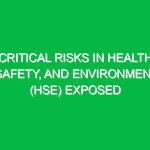Introduction
In the Health, Safety, and Environment (HSE) domain, identifying warning signs is crucial for preventing accidents, injuries, and environmental damage. Warning signs are indicators that signal potential Hazards or risks. Recognizing these signs early can empower organizations to take proactive measures, ensuring the well-being of employees, the public, and the environment. This article delves into the significance of warning signs in HSE, explores the various types of warning signs, and discusses Best Practices for implementing effective Safety Measures.
Understanding Warning Signs
Warning signs are visual cues or messages designed to alert individuals about potential dangers. These signs can take many forms, from simple labels on chemicals to complex emergency exit signs in a building. In the HSE context, warning signs serve several key functions:
- Awareness: They inform individuals about specific Hazards, enabling them to take necessary Precautions.
- Prevention: By highlighting risks, warning signs can prevent accidents before they occur.
- Compliance: Many Regulations require the use of warning signs to protect workers and the environment, ensuring organizations remain compliant.
Recognizing warning signs are essential for fostering a culture of Safety in any organization.
The Types of Warning Signs
In the realm of HSE, warning signs can be categorized into several types:
1. Chemical Hazard Signs
Chemical hazard signs indicate the presence of hazardous materials. These signs often include symbols that communicate the nature of the hazard, such as toxicity, flammability, or corrosiveness. For example, the skull and crossbones symbol signifies a toxic substance.
2. Biological Hazard Signs
Biological hazard signs alert individuals to the presence of biological agents that can cause harm. These signs often feature the biohazard symbol, indicating exposure to potentially infectious materials.
3. Physical Hazard Signs
Physical hazard signs denote risks associated with machinery, equipment, or environmental conditions. They may include warnings about moving parts, high voltage, or slippery surfaces. For instance, a “Caution: Wet Floor” sign is a common physical hazard warning.
4. Emergency Signs
Emergency signs guide individuals during critical situations, indicating evacuation routes or emergency exits. These signs are typically illuminated and designed to be easily recognizable, ensuring individuals can quickly find their way to Safety.
5. Warning Labels
Warning labels are often found on products, providing essential information about Safe Usage and potential hazards. For instance, a cleaning product may carry a label warning users to wear gloves and avoid contact with skin.
Recognizing Warning Signs in Practice
To effectively implement warning signs within an organization, it is crucial to foster a culture that encourages awareness and vigilance. Here are practical steps to enhance the recognition of warning signs:
- Training: Regular Training sessions should be conducted to educate employees about various warning signs and their meanings. This training can include hands-on demonstrations and real-life scenarios to reinforce learning.
- Visible Placement: Ensure that warning signs are placed in locations where they are easily visible. For example, chemical hazard signs should be prominently displayed near the substances they refer to.
- Regular Audits: Conduct regular safety audits to assess the effectiveness and visibility of warning signs. This process can help identify areas for improvement.
Potential Hazards and Risks
Failing to recognize warning signs can lead to severe consequences, including workplace accidents, environmental disasters, and legal liabilities. For example, in 2010, a catastrophic accident at a chemical plant in the United States was attributed to the absence of proper warning signs. Employees were unaware of the hazardous chemicals they were working with, leading to a massive explosion that resulted in injuries and significant environmental damage.
Moreover, industries such as construction and manufacturing face unique risks. Workers may encounter various hazards, from heavy machinery to toxic substances. Without the proper warning signs in place, accidents can occur, jeopardizing not only the health and safety of workers but also the surrounding community.
Best Practices for Implementing Warning Signs
To ensure the effectiveness of warning signs, organizations should adopt Best Practices:
- Standardization: Use standardized symbols and terminology to avoid confusion. Organizations should refer to established guidelines, such as those from the Occupational Safety and Health Administration (OSHA) or the National Fire Protection Association (NFPA).
- Regular Updates: Regularly review and update warning signs to reflect changes in processes, materials, or regulations. This practice ensures that employees are always aware of current hazards.
- Feedback Mechanism: Establish a feedback mechanism that allows employees to report issues with warning signs. This feedback can help improve the visibility and clarity of signs.
Regulations and Standards
Various regulations and standards govern the use of warning signs in the HSE context. In the United States, osha mandates that employers provide a safe workplace, which includes the proper use of warning signs. OSHA’s standards require that signs be understandable and reflect the nature of the hazard.
Additionally, the Globally Harmonized System of Classification and Labelling of Chemicals (GHS) provides a framework for labeling hazardous substances. This system emphasizes the importance of clear and consistent communication regarding chemical hazards, ensuring that warning signs are both informative and compliant with international standards.
The Role of Technology in Warning Signs
In recent years, technology has played a pivotal role in enhancing warning signs and their effectiveness. Digital signage and smart technology can provide real-time information about hazards, improving safety communication. For instance, sensor-based warning systems can alert workers to changes in environmental conditions, such as increased chemical exposure or rising temperatures.
Moreover, virtual reality (VR) training programs can simulate hazardous environments, allowing employees to practice recognizing warning signs in a controlled setting. Such innovative approaches not only enhance training but also reinforce the importance of vigilance in recognizing warning signs.
Conclusion
In conclusion, recognizing and effectively implementing warning signs are critical components of Health, Safety, and Environment success. These signs serve as essential tools for raising awareness, preventing accidents, and ensuring compliance with regulations. By fostering a culture that prioritizes safety and vigilance, organizations can significantly reduce risks and promote a healthier, safer environment for all.
As we move forward, it is imperative that industries continue to innovate and improve their approaches to warning signs. By embracing technology and adhering to best practices, organizations can enhance their safety protocols, ultimately leading to a more sustainable future. Recognizing the importance of warning signs is not just a regulatory requirement; it is a commitment to the well-being of employees, the community, and the environment.


